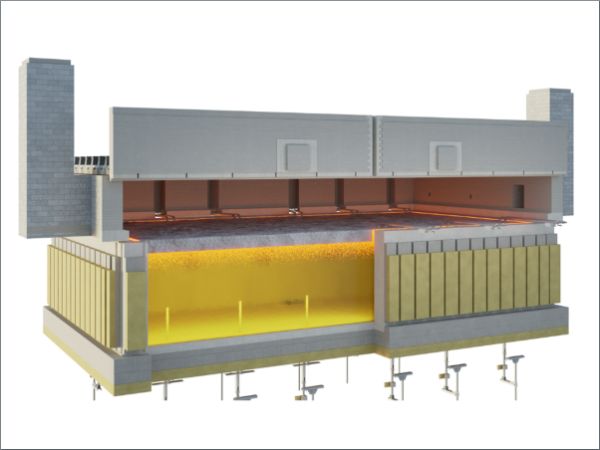
Date: 15 August 2024
In general all electric furnaces with a cold top are used typically for a production range of 5 – 80 t/d with the possibility given to increase the melting capacity up to 200 t/d (or even beyond that). For this furnace type energy is not supplied by means of fossil fuels, but exclusively by means of electric energy supplied by molybdenum electrodes.
The melting, refining and homogenising processes in all electric furnaces are typically happening in a vertical direction, in contrast to the horizontal direction for fossil fueled furnaces.
In all electric furnaces the batch layer is the focal point in operating the furnace. A delicate balance for the batch thickness must be found to prevent high energy losses on the one side and an improper melting process on the other side. For this reason the flexibility in regards to pull changes and culet fraction is restricted, but can be improved by means of furnace design.
The specific pull is higher and not comparable with fossil fuel fired furnaces due to vertical melting process. The glass quality can be drastically higher than in a fossil fuel fired furnace. For this reason, high quality specialty glass, e.g. for optical applications, is often molten with all electric furnaces.
The energy consumption of all electric furnaces is lower than the one of fossil fired furnaces. This advantage is especially true for furnaces with small pull rates, making them even more cost efficient. Increasing costs for CO2 allowances can be a deciding factor for all electric furnaces despite higher costs for electric energy in the near future.
FEATURES
- Reduced dusting of the batch due to missing flame gases
- Usage of a very cheap bag filter system is possible
- Suitable for production of special glass with expensive, volatile and aggressive components in the batch
- No emissions due to firing (NOx, CO2)
- Shorter lifetime and thus shorter time until improvement
- Short time from glass to glass in case of brick to brick repair
Join HORN at glasstec 2024 to talk about the possibilities of using electric energy in glass melting in the form of HORN hybrid furnaces, super hybrid furnaces or all electric melting furnaces.
Further information at Furnaces (hornglass.com)
 600450
600450










Add new comment